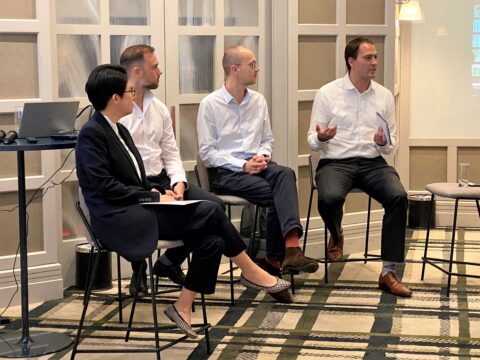
(L-R) Goh Wanjing; Nathan Reeves; Fred Fitzalan Howard; Charles Griffith
23 March 2023
Elizabeth Low, Senior Analyst, ESR
In July 2022, a pilot scheme was publicly launched in Singapore to invite innovative proposals as part of a calibrated growth of data centres. With the anticipated buzz around the announcement, ULI Singapore NEXT organised a session as part of the “The Next Phase” series to discuss all things data centres – the opportunities and market demand both in Singapore and the region; the design factors that would contribute towards occupiers’ ESG commitments; and the key legal considerations impacting data centres.
The session was kicked off with a presentation on the Asia Pacific data centre market by Fred Fitzalan Howard, Associate Director, Knight Frank, who leads the consultancy’s Data Centre Advisory team in Asia Pacific. Data centres serve as crucial infrastructure for today’s highly connected and digitalised climate, with every click on our phones and on the Internet relying on data centres. In particular, Fred highlighted that the supply and take-up of IT power in Asia Pacific almost doubled in 2019/2020.
Data centres started being at the forefront of the sector around 2014 to 2015 with the emergence of cloud solutions, which has driven growth of hyperscalers such as Microsoft, Amazon Web Services (AWS), Zoom, and Google who now dominate the data centre market globally.
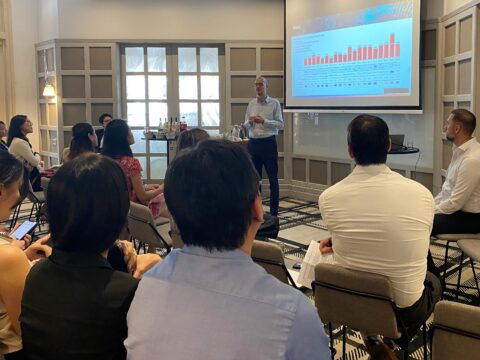
Fred Fitzalan Howard, Associate Director, Knight Frank
Land acquisition for data centres has been known to be extremely tricky. Fred expounded some factors to consider for data centre site selection – these included proximity to current or future availability zones, land sizes of ideally 10,000 to 20,000 sqm, power provision, fibre connectivity, dual independent access for fibre and fire trucks, and various risks including flight path risks, tall buildings, residential areas, petrol stations, and flooding.
With the increasing prominence of data centres as an asset class, investors have assessed the sector through various manners such as mergers and acquisitions (M&As), joint ventures, and value-add land acquisitions and disposals. A prolific example of a joint venture in Asia Pacific that Fred cited is ESR Group and US-based operator Stack Infrastructure’s team-up for a 72-megawatt data centre campus in Osaka, Japan, following an initial joint venture in Seoul, South Korea.
Fred wrapped up his presentation with trends we can look out for in 2023: an increase in M&As and land acquisitions in emerging Tier 2 cities such as Bangkok, a growing focus on data residency and sovereignty, continued supply chain disruptions and delays, and a larger emphasis on sustainability in data centre development.
The time was handed over to Nathan Reeves, Commissioning Lead – APAC, RED. A company of ENGIE Impact, RED is a consultancy focusing on sustainable development and low carbon solutions.
Nathan’s presentation mainly focused on green features in data centre design, particularly in Singapore. Data centres are notoriously known for being “power sucking machines”, but steps are being made towards overcoming various challenges for more sustainable development.
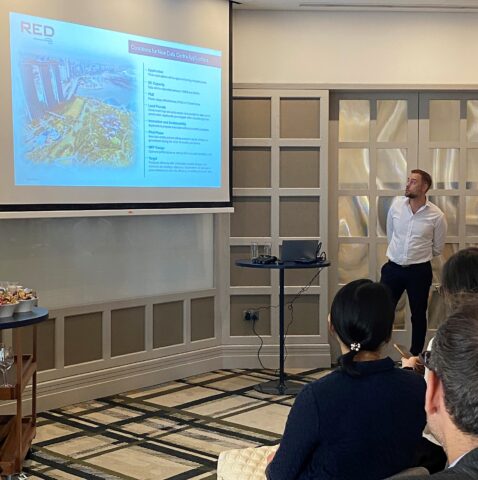
Nathan Reeves, Commissioning Lead (APAC), RED
Focusing the discussion on the launch of the pilot program by the authorities with an aim for more calibrated and sustainable growth of data centres in Singapore, Nathan highlighted some conditions for new data centre applications, including power usage effectiveness (PUE) of 1.3 and below (this used to be >2), solutions proposed to be innovative and sustainable, and resource efficiency with contribution towards Singapore’s economic and strategic objectives.
As the sector progresses, innovative data centre technological solutions have continually emerged, centered on the sustainability of data centre design. Some examples include high-density liquid cooling of IT equipment, hydrogen as a utility for both prime generation fuel and energy storage, battery energy storage systems, and the reduction of embodied carbon especially through Power Purchase Agreements (PPAs) as they remain the easy solution towards carbon neutralises. With these in mind, Nathan opined that a data centre run on 100% renewable energy would be possible, on the back of long-term on-site innovative and carbon neutral holistic solutions.
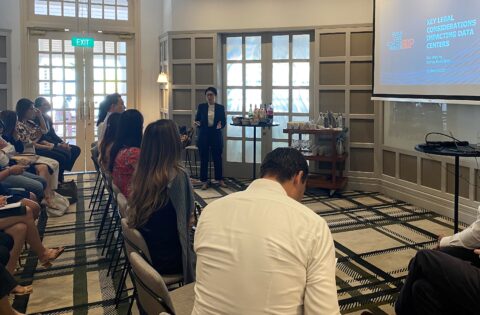
Goh Wanjing, Partner, Bryan Cave Leighton Paisner LLP
The time was subsequently handed over to Goh Wanjing, Partner, Bryan Cave Leighton Paisner LLP. For her presentation, Wanjing mainly examined Singapore’s pilot data centre program as a framework to look at requirements, legal considerations, and statutes, standards and schemes.
Zooming into the key requirements for Singapore’ pilot data centre application exercise, the requirements under sustainability mainly revolve around energy efficiency and decarbonisation for strategic and economic objectives to support Singapore’s position as a regional and international connectivity hub.
Given the complexity of data centre development, it is imperative to bear legal considerations in mind. While these span across a wide range of concerns such as corporate and finance, data privacy and cybersecurity, and tax incentives; Wanjing focused her presentation on energy and environment, and development and construction considerations. There have been various statutes and standards enacted in Singapore by the Building and Construction Authority (BCA), Infocomm Media Development Authority of Singapore (IMDA), Energy Market Authority and Public Utilities Board for sustainable data centre development.
A best-in-class, efficient data centre is expected to meet the Building and Construction Authority (BCA)’s Green Mark for Data Centre (Platinum) certification standards. This is a dedicated green building system designed to encourage the adoption of energy efficient design, operation and management of data centres.
Another notable example Wanjing brought up in relation to energy efficiency is the SS 564: Singapore Standard (Sustainable Data Centres). First published in January 2011 by IMDA in partnership with other government agencies and industry, there have been two subsequent revisions in 2013 to the set of best practices. In essence, the SS 564 is a certifiable management system which provides data centres with a recognised framework and methodology to achieve sustainability and improvements in the area.
Panel Discussion moderated by NEXT committee member Charles Griffith, Director, Macquarie Asset Management

(L-R) Goh Wanjing; Nathan Reeves; Fred Fitzalan Howard; Charles Griffith
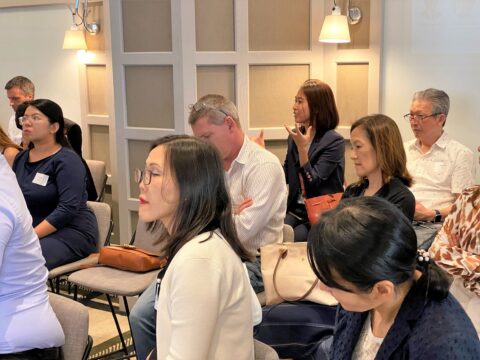
Active Q&A with audience
The session was wrapped up with a panel and audience discussion led by Charles Griffith, Director – Real Estate, Client Solutions Group, Macquarie Group; which focused on challenges in investing in data centres and the Asia Pacific data centre market.
In terms of challenges in investments, Fred brought up the rising interest rates which have dampened investor interest across the board. However, the biggest challenge for many data centre operators remains cost of land and land availability – operators are being priced out of the market, and land suitable for data centre development is scarce especially with developers also seeking such land opportunities. Other challenges include obtaining building permits and local regulations; Singapore’s moratorium which was recently lifted is a good example.
When asked about the most important factor to consider for data centre development, Nathan emphasised on land selection to ensure that power is sufficient and accessible.
Given that Asia Pacific is a highly diverse region, Fred mentioned that Asia Pacific is mainly split into Tier 1 and Tier 2 cities, where Tier 2 cities such as Thailand, Malaysia, Vietnam, and Indonesia provide more opportunities for cheaper land and power. However, Wanjing highlighted that there are higher risks when entering an emerging market. As such, proper risk assessment and due diligence are key.
Ultimately, while data centres continue to be an asset class that investors focus on, it is crucial to ensure that sustainability is a key factor in play for data centre design. With ESG at the forefront of both investors and occupiers’ agendas, the industry will continue to transform in ways that move towards net zero and carbon neutrality.
ULI Singapore and its NEXT Committee thanks the panel and audience for their active sharing and inputs on this important and rising feature of our built environment. We also thank our Patron supporter, The Great Room for being our venue host.
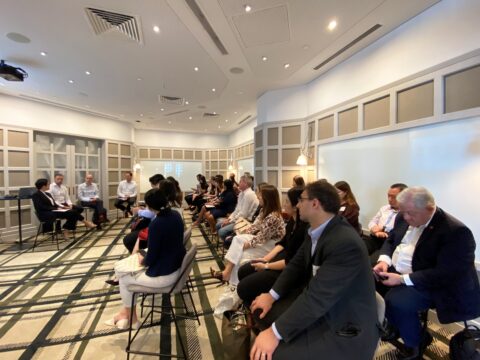
Interdisciplinary audience of developers, consultants, architects and investors
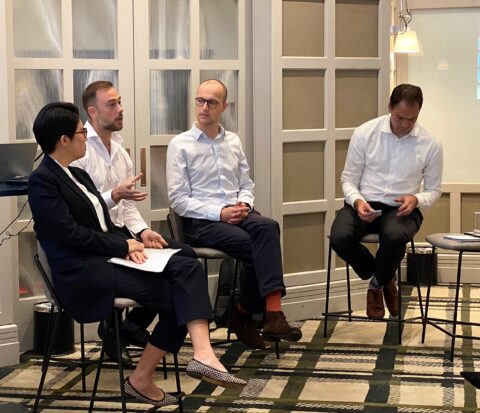
Nathan Reeves responding to an audience question on greening a data centre
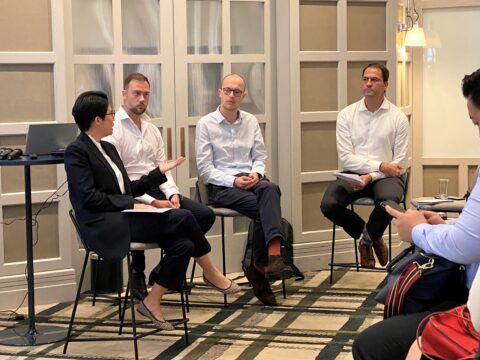
Goh Wanjing shared her legal expertise related to data centres
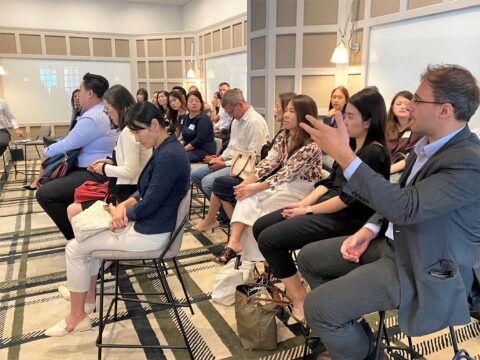
Active participation from the audience
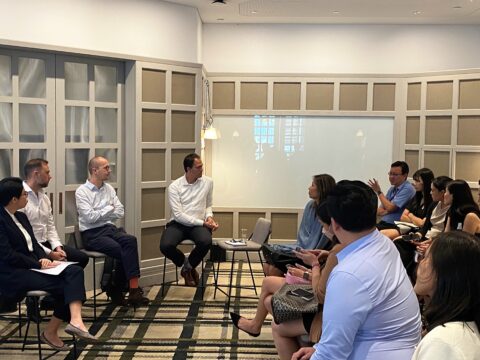
Active participation from the audience
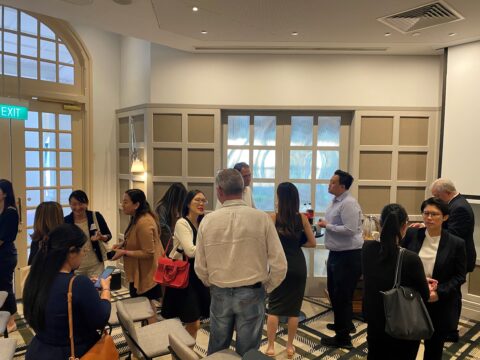
Post-event networking
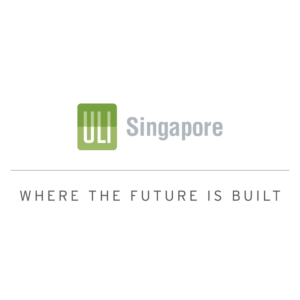
Don’t have an account? Sign up for a ULI guest account.

Interdisciplinary audience of developers, consultants, architects and investors

Nathan Reeves responding to an audience question on greening a data centre

Goh Wanjing shared her legal expertise related to data centres

Active participation from the audience

Active participation from the audience

Post-event networking